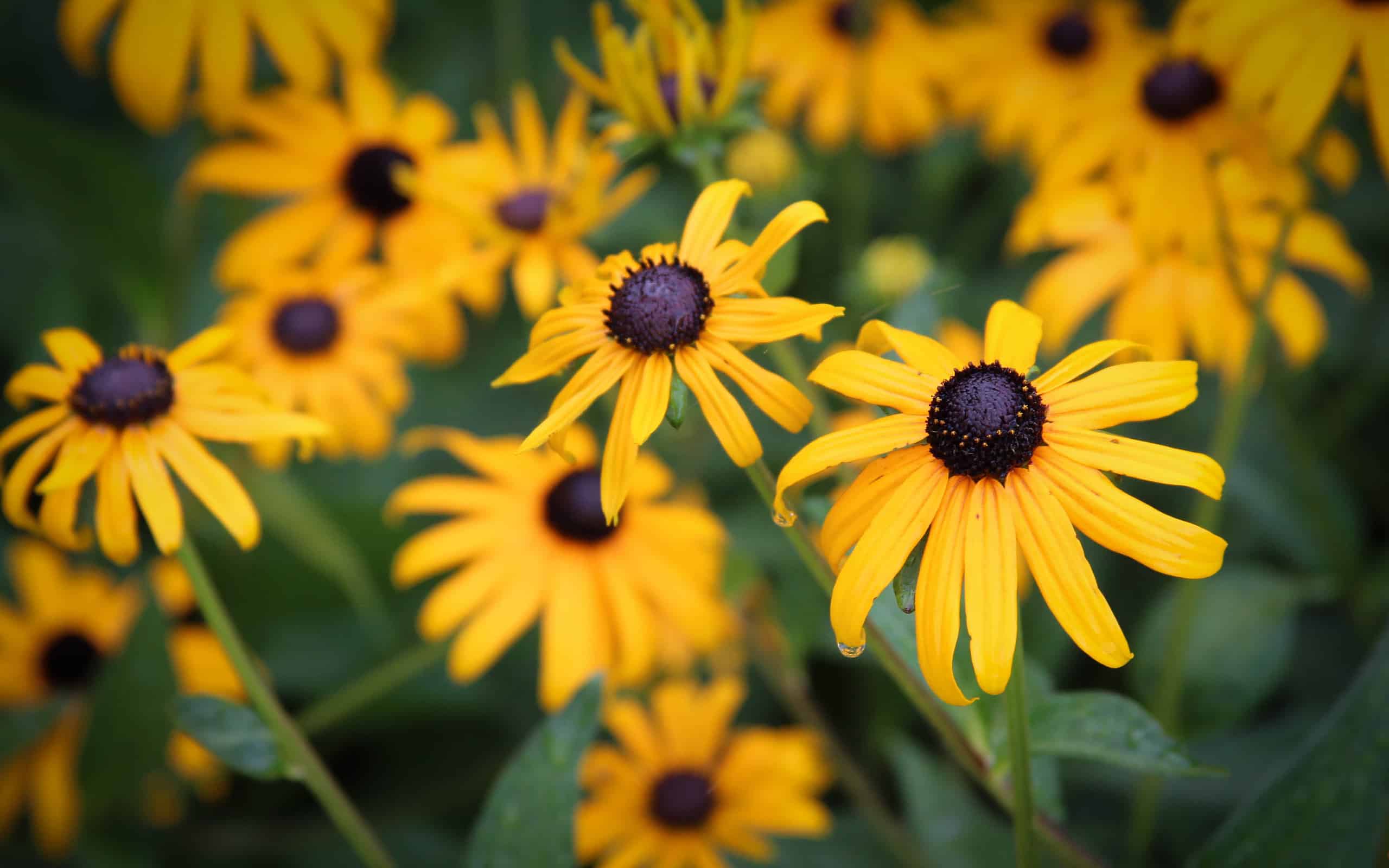Bourbon, bluegrass, and horses are synonymous with Kentucky. Kentucky is the birthplace of 95 percent of the world’s bourbon. Bill Monroe, known as the Father of Bluegrass Music, was born in Rosine, Kentucky. In Lexington, you can visit the Kentucky Horse Park, which spans over 1,200 acres. Kentucky is also the home of the Daniel Boone National Forest, a massive wilderness area reaching into 21 different counties. You’ll find plenty of plant life in Kentucky, including beautiful flowers that Kentuckians can plant at home.
What is Kentucky’s Climate?
According to the Koppen-Geiger Climate Classification System, a majority of Kentucky enjoys a humid subtropical climate. Summers are warm to hot while winter weather conditions are mild to cold. Most of Kentucky is USDA Plant Hardiness Zone 6. Sections of Western Kentucky, including Calloway, Graves, and Fulton counties, fall into Zone 7A. Consult the USDA Plant Hardiness Map before choosing plants for your Kentucky garden.
Let’s take a look at 20 of the best flowers to plant in Kentucky gardens!
1. Garden Petunia (Petunia x hybrida)
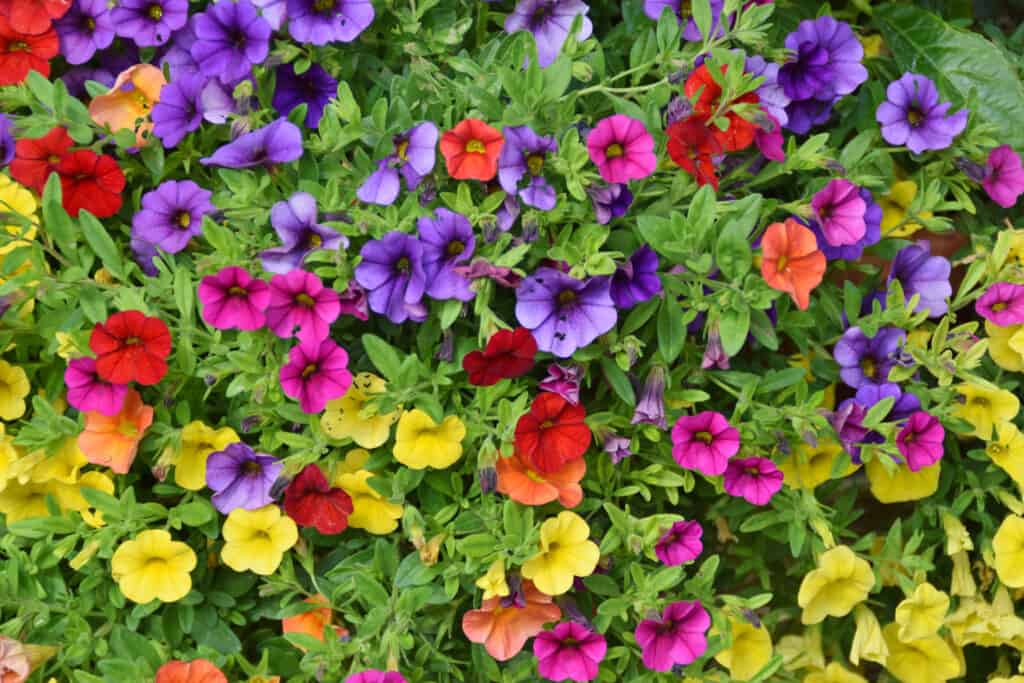
Even though garden petunias are members of the nightshade family, the flowers are non-toxic.
©Eleonora Scordo/Shutterstock.com
Whether you place them in a container or plant them directly in the ground, garden petunias will create a patch of gorgeous blooms in any Kentucky outdoor space. Before you garden petunias, consider what kind of effect you’re trying to achieve. Grandiflora garden petunias present flowers that are three or more inches across. Multifloras are smaller plants while milliflora petunias are tiny enough to use for edging or border flowers. Spreading petunias work well as ground cover or in decorative hanging baskets.
April is the best month to plant garden petunias when the threat of frost has passed. Garden petunias produce the most blooms when planted in full sun. They’ll tolerate partial shade, but fewer flowers will develop. Garden petunias prefer rich, moist, and well-draining soil. If necessary, fortify the soil with compost before planting. Mature garden petunias bloom from late spring until the first frost. During the hottest part of the summer, garden petunias may need to be watered twice a day. Deadheading faded flowers encourages garden petunias to continue producing blooms. With a little care, garden petunias will put on a colorful show all summer long!
2. Hardy Chrysanthemum (Chrysanthemum)

In Greece, chrysanthemums are believed to ward off evil spirits.
©Mariia Romanyk/Shutterstock.com
Fall brings about a proliferation of hardy chrysanthemums in Kentucky gardens. In containers, hardy chrysanthemums are focal points of fall displays. Planted in the ground, hardy chrysanthemums bring a much-needed splash of color to outdoor spaces as other flowers start to fade. Wait until after the last spring frost to plant hardy chrysanthemums in the garden. Hardy chrysanthemums can be planted from containers into the ground during the fall. However, there may not be enough time for those plants to become well-established. It takes six to eight weeks for hardy chrysanthemums to form a decent root system. If planted too late, hardy chrysanthemums may not survive the winter.
Hardy chrysanthemums prefer rich, well-draining soil with full sun exposure. Keep the soil moist but not soggy. Some varieties of hardy chrysanthemums begin blooming towards the end of July while others don’t begin showing flowers until October. Flowers last from between four to eight weeks. Hardy chrysanthemums contain pyrethrin, a toxic compound that repels annoying pests like mosquitoes. Pyrethrin is also toxic to cats, dogs, and horses, so keep your animals away from hardy chrysanthemums.
3. Spider Flower (Cleome houtteana)

Small hairs on the foliage of the spider flower produce a sour aroma comparable to the smell of a skunk.
©Emmy Liana Dewi/Shutterstock.com
Eye-catching height and blooms make spider flowers a fine fit for cottage gardens or as border plants in a garden bed. These flowers reach heights of between three to six feet. White, purple, or pink blooms present themselves beginning in early summer. Sticking out from the flowers are long stamens which resemble the legs of a spider. After the last frost, sprinkle spider flower seeds in loamy, well-draining soil. Light is required for spider flower seeds to take root. Spider flowers love full sun exposure. Once established, spider flowers are drought tolerant. Mulching around spider flowers helps the plants retain moisture. When the flowers are spent, seed pods appear. Spider flowers re-seed easily, so remove the seed pods to keep spider flowers in check. Despite their ability to reseed, spider flowers are not considered invasive.
4. Creeping Zinnia (Zinnia angustifolia)

Don’t worry about your outdoor pets! Creeping zinnia is non-toxic.
©Bigc Studio/Shutterstock.com
Zinnias are known for their large flowers. Creeping zinnia features smaller blooms than common zinnia, but it is resistant to diseases like powdery mildew that affect common zinnias. That resistance helps creeping zinnia look beautiful all throughout its blooming season. Creeping zinnias are not tolerant of frost and do not perform well in cool-to-cold weather. Kentuckians should wait until late April or May until planting creeping zinnia. Choose a place in your garden that has rich, loamy, well-drained soil. Give creeping zinnia full sun exposure to produce the greatest number of blooms. Blooms will last from June until the first frost. Flowers draw in a variety of pollinators, from bees to butterflies. Mature creeping zinnia is drought-tolerant with minimal watering requirements. Easy to grow and pleasing to show, creeping zinnia is a gorgeous summer flower.
5. Threadleaf Coreopsis (Coreopsis verticillata)

Birds like to eat the tiny seeds of threadleaf coreopsis.
©DavidMicD/Shutterstock.com
Native to Kentucky, threadleaf coreopsis brings a bright yellow shock to outdoor spaces. Two-inch wide flowers sit upon thin stems above narrow dark green thread-like leaves. Pollinators are attracted to the blooms, filling your garden with activity. Threadleaf coreopsis seeds can be planted in early spring or fall. You can divide threadleaf coreopsis for propagation in fall or spring. Place threadleaf coreopsis in well-drained rocky soil that stays dry to moderately moist. Threadleaf coreopsis grows well with full sun exposure. Soggy soil leads to crown rot. Blooms begin appearing in June and often remain until September. Deadheading the spent flowers encourages bloom production. Threadleaf coreopsis self-seeds readily. Removing the dead flowers discourages the spread of the plant. Low maintenance and drought-tolerant, threadleaf coreopsis creates a long-blooming, lovely visual aspect in the garden.
6. Purple Coneflower (Echinacea purpurea)
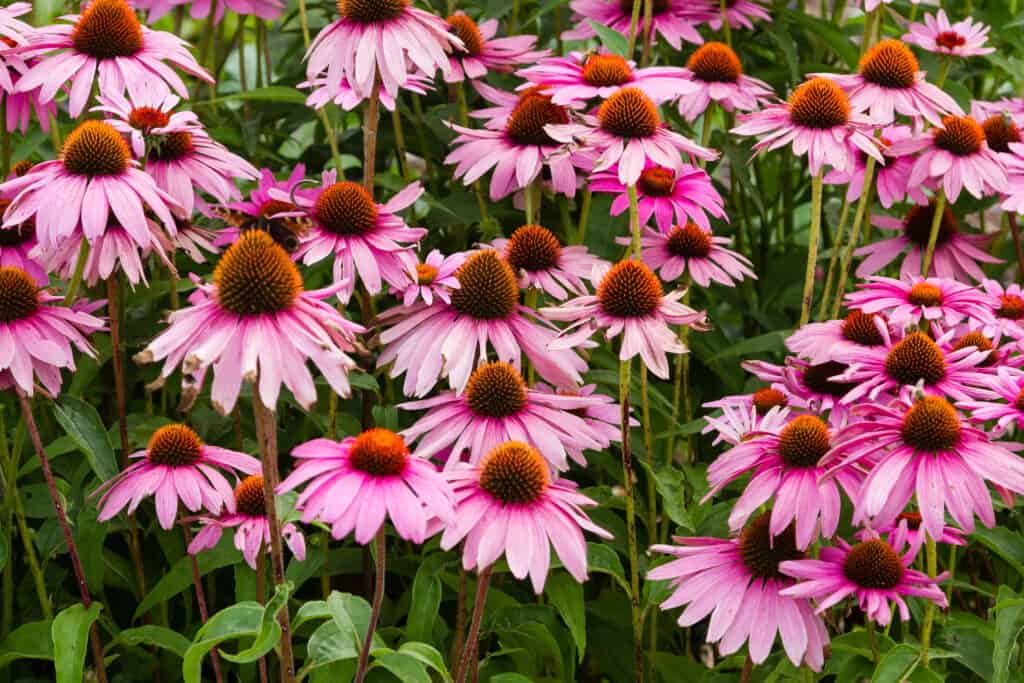
Echinacea tea is believed to bolster the human immune system.
©Milosz Maslanka/Shutterstock.com
Embrace the power of purple by planting some purple coneflower in your garden! Growing up to five feet high, purple petals droop down from a centrally placed brown-orange disc. Purple coneflowers make a splendid focal point within a group of wildflowers or mass planting in a butterfly garden. Easily planted from seed in the spring, established purple coneflowers begin blooming in April and continue into September. Purple coneflowers thrive with at least six hours of full sunlight per day. These plants flourish in multiple soil conditions as long as the soil drains well. Purple coneflowers will overtake and crowd out other plants if left alone. Remove the flower heads after blooming to prevent reseeding. Let the flower heads remain and birds will come to eat the seeds.
7. Daylily (Hemerocallis)
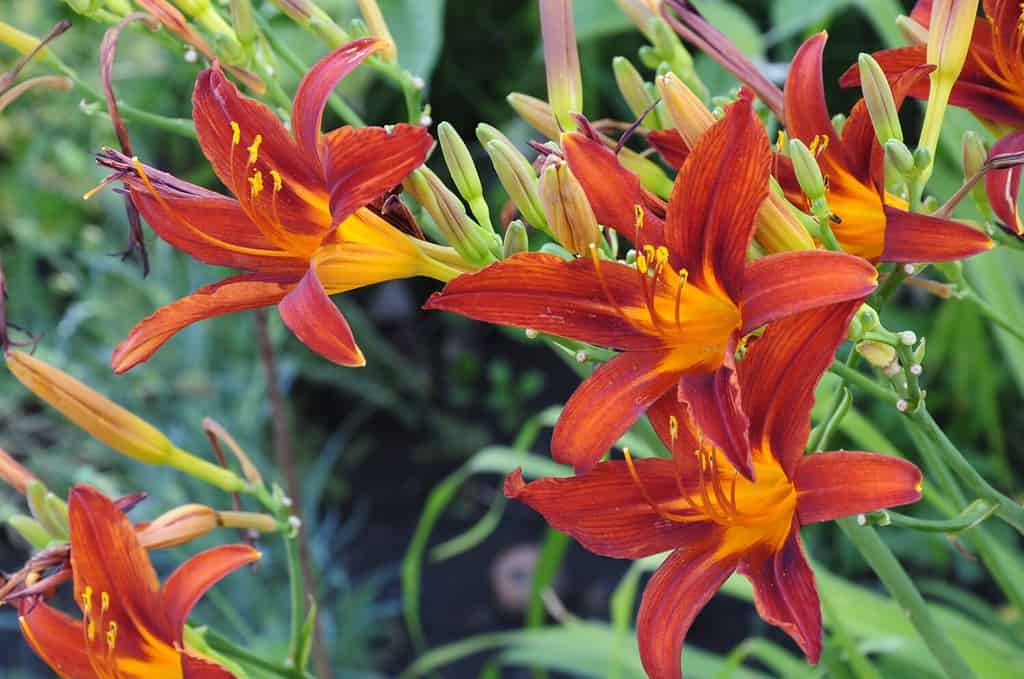
Greek in origin, the genus name “Hemerocallis” translates roughly to “beauty for a day.”
©Fayka2008/Shutterstock.com
Beautiful and highly adaptable, daylilies help Kentucky gardeners welcome warm weather to their region. As early as March, daylilies will begin popping up and producing large six-petaled blooms on strong stems. Although individual blooms only last for one day, daylilies produce a number of buds that will allow them to produce flowers for up to five weeks. Stick daylilies in the ground in the early spring or the beginning of fall. Choose a place where daylilies will receive full sun. They need well-draining soil, preferably chalky or loamy, but will adapt to various soil conditions. If the soil is poor, amend it with peat moss or compost. Because of hybridization and cross-pollination, daylilies planted from seed may produce different strains. Propagation is best achieved by dividing mature plants every four years. Although parts of the daylily are safe for both dogs and humans to consume, daylilies are highly toxic to cats.
8. Autumn Joy Sedum (Hylotelephium spectabile ‘Herbstfruede’)
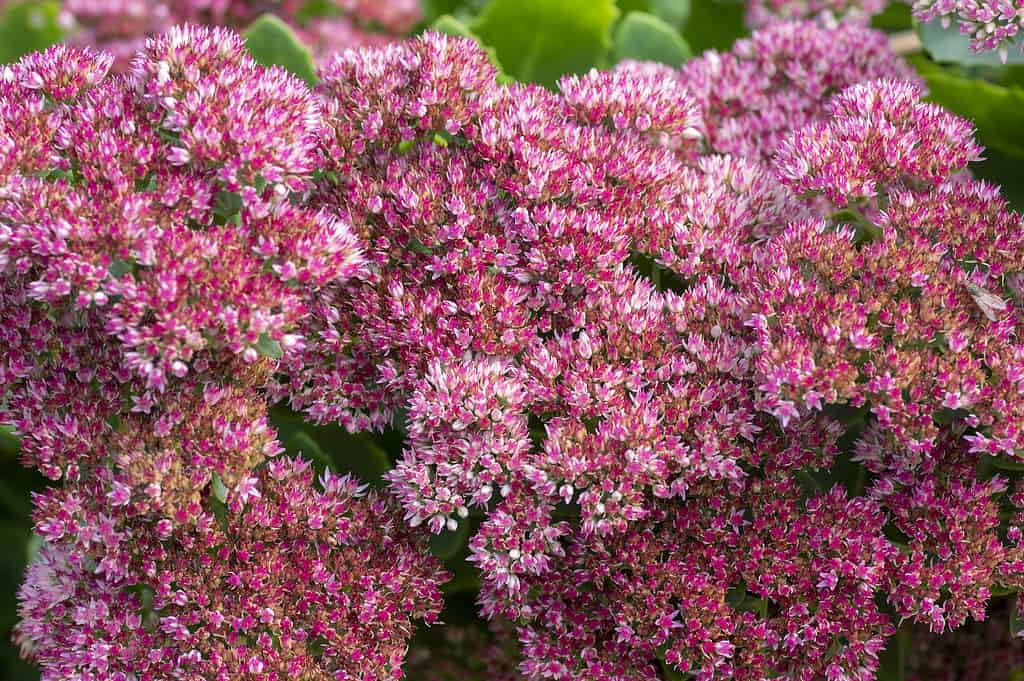
Use Autumn Joy sedum in cut flower arrangements during the fall.
©Iva Vagnerova/ via Getty Images
If hardy chrysanthemums don’t provide enough fall color, place some Autumn Joy sedum in the garden! This perennial blooms from mid-to-late summer through October, displaying hues of orange, pink, red, or yellow. Compact in size, Autumn Joy sedum grows two feet high and wide. Prune in late spring if the plant gets too large for its space. Autumn Joy sedum is propagated by cuttings that can be planted in spring after the final frost. Poor to average rocky soil is best for Autumn Joy sedum. This plant won’t thrive if the soil is too rich. Make sure the soil is well-drained. Autumn Joy sedum thrives in areas where it receives full sun exposure. Its water needs are minimal. Watering once every two weeks is enough to keep this plant happy. Autumn Joy sedum holds on to its shimmery foliage through the winter as it waits for spring to come back around.
9. Mealy Cup Sage (Salvia farinacea)

Bees and butterflies are drawn to the delicate blooms of mealy cup sage.
©TuiPhotoEngineer/Shutterstock.com
Boasting tall stalks of blue flowers, mealy cup sage is visually striking when planted in groups. Consider planting mealy cup sage toward the rear of the garden to serve as a background for other bedding plants. While mealy cup sage is a perennial in warmer USDA cold hardiness zones, it is grown as an annual in Kentucky. Growing mealy cup sage from seed is easy. After the last spring frost, press mealy cup sage seeds into the soil rather than completely covering them. These seeds require light to germinate. Blooms should appear within four months. Look for mealy cup sage to bloom from late spring until fall. Full sun will promote the best bloom production, but mealy cup sage also tolerates partial shade. Make sure the soil is well-drained. Mealy cup sage prefers loamy soil but grows well in various soil conditions. Amend poor soil if necessary. Mealy cup sage is drought-tolerant, and able to thrive in hot Kentucky summers.
10. Common Impatiens (Impatiens walleriana)
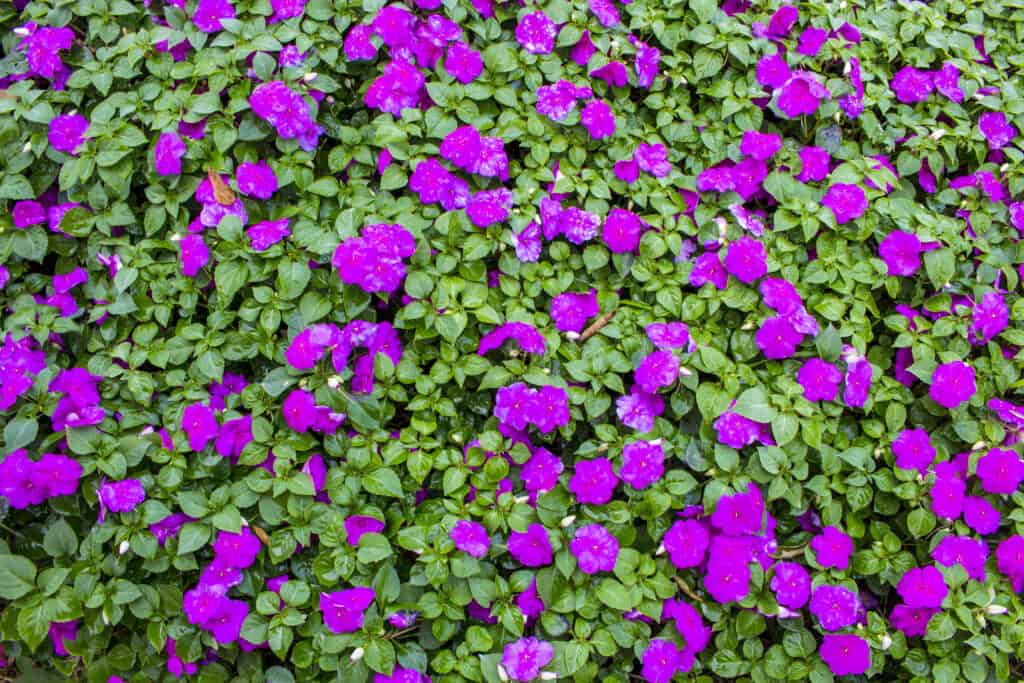
The genus name, “Impatiens,” is a Latin word which means “impatient.”
©AkwaN/Shutterstock.com
Hugely popular in Kentucky, common impatiens are ideal for shady areas of the garden. Not only do common impatiens produce a huge amount of blooms, they are simple to grow. Late spring is the best time to put common impatiens in the ground. If the soil is too cool, the plant will not perform as desired. Place common impatiens in rich, moist, and well-drained soil. Full sun is bad for common impatiens, so plant them in partial to full shade. Add common impatiens to your watering schedule. Two inches of water per week is the general recommendation. If you notice your common impatiens beginning to wilt, some extra water will perk them up. Common impatiens are annual plants in Kentucky, but they self-seed easily. You could wind up with some volunteer common impatiens during the next growing season!
11. Cardinal Flower (Lobelia cardinalis)
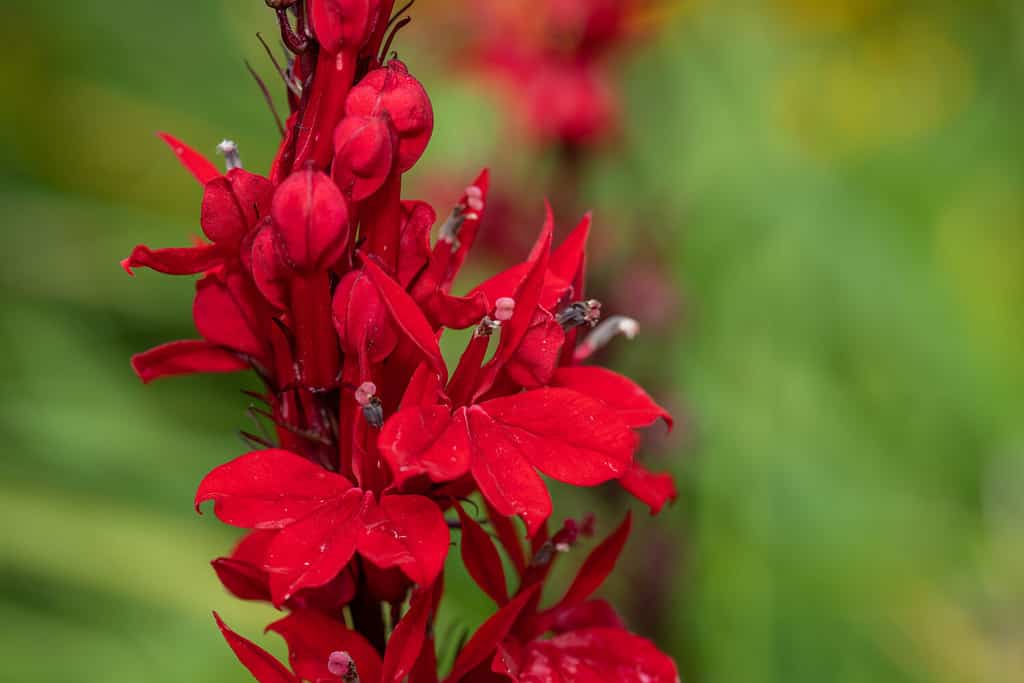
Indigenous peoples used parts of the cardinal flowers in the creation of love potions.
©Tom Meaker/Shutterstock.com
Notable for its red petals that resemble flowing robes, the cardinal flower is perfect for outdoor areas where the soil stays moist. It begins blooming in mid-to-late summer. The flowers, which develop on a strong spiky stem, remain until the middle of fall. Cardinal flowers grow to a height of two to four feet. They will perform well in full sun or partial shade. Rich soil is best for cardinal flowers. These plants like constant moisture around their roots. Don’t let the soil dry out. A layer of mulch around the plant helps the soil remain moist. Consider planting cardinal flowers by a pond or in a water garden. Cardinal flowers are toxic, so keep pets and livestock away.
12. Black-Eyed Susan (Rudbeckia hirta)

After areas have been ravaged by wildfire or natural disaster, Black-eyed Susans are one of the first plants to grow back.
©LauraTabor/iStock via Getty Images
A familiar sight to Kentucky gardeners, Black-eyed Susans deliver sunny color to your yard. Black-eyed Susans grow wild in Kentucky, but they have been incorporated into landscapes and gardens. Flowers consist of yellow-to-orange rays surrounding a blackish-brown central cone. Black-eyed Susans begin blooming in June before fading in September. Seeds of the Black-eyed Susan require cold stratification for proper germination. Plant them in the fall or six weeks before the last frost. These flowers love loamy, well-draining soil and full sun exposure. Mature Black-eyed Susans produce a great number of seeds. Those seeds are an excellent food source for birds. However, some of those seeds may hit the ground and germinate, leading to Black-eyed Susans spreading throughout the garden. Deadhead the spent blooms, including the central cone where the seeds appear, to reduce aggressive spreading.
13. Tall Goldenrod (Solidago altissima)
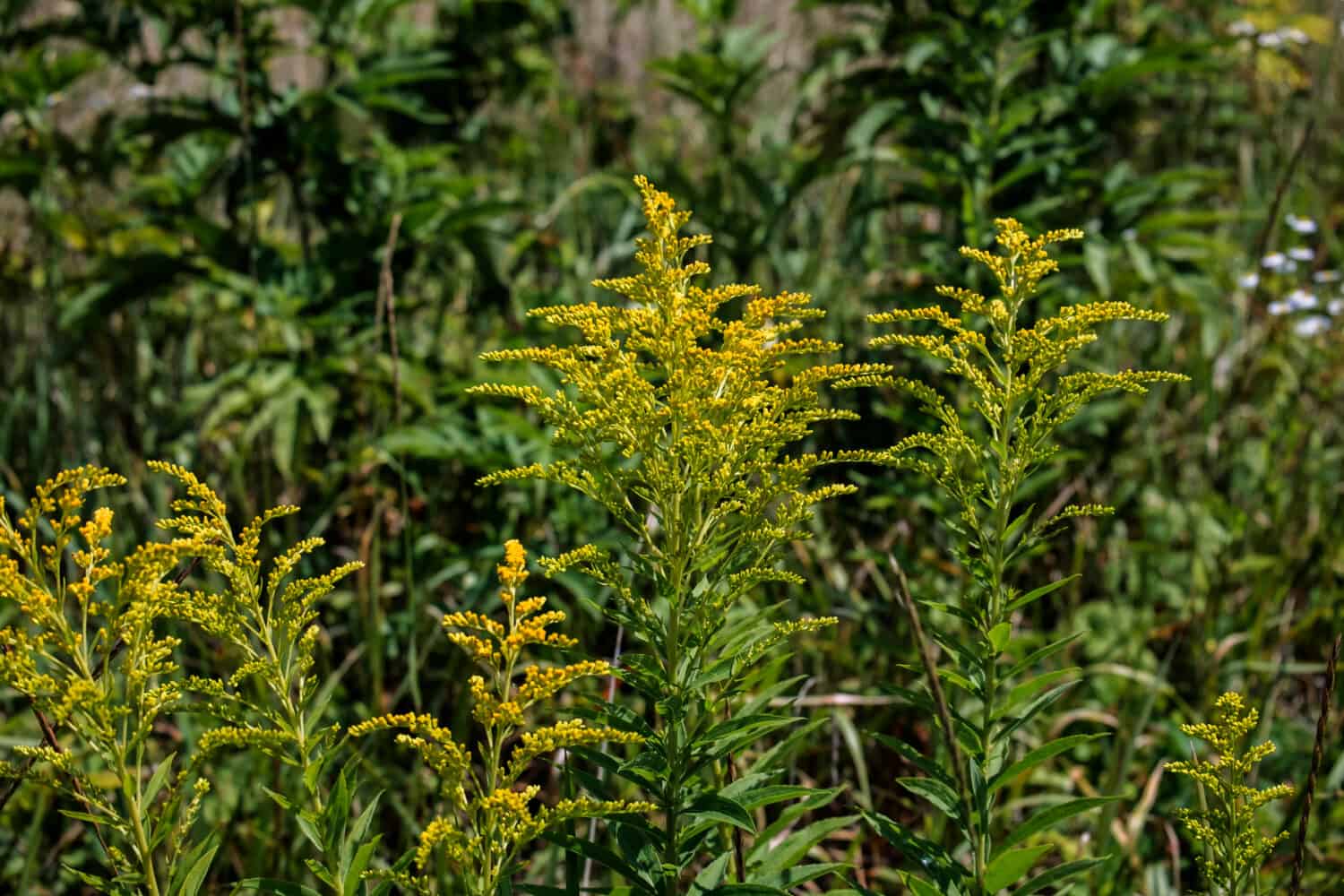
Kentucky’s state flower is the tall goldenrod.
©McGraw/Shutterstock.com
Bring beauty to larger areas of open land by planting patches of tall goldenrod! True to its name, tall goldenrod can attain heights of over six feet. When in bloom, the arching stems of tall goldenrod are dotted by dozens of tiny yellow flowers. Blooms begin to appear in the late summer and early fall. Tall goldenrod can tolerate some shade, but the best bloom production occurs in exposure to full sun. It thrives in a variety of soil conditions as long as the soil is well-drained. Tall goldenrod spreads through rhizomes and by self-seeding. It will spread and take over small gardens. Give tall goldenrod some room to grow and expand. Cold stratification is required for tall goldenrod seeds to germinate. Plant seeds in the ground during the late fall or early spring. Some Kentuckians may worry about tall goldenrod triggering symptoms of hay fever. However, it is actually ragweed, not goldenrod, that elicits hay fever reactions.
14. Virginia Bluebells (Mertensia virginica)
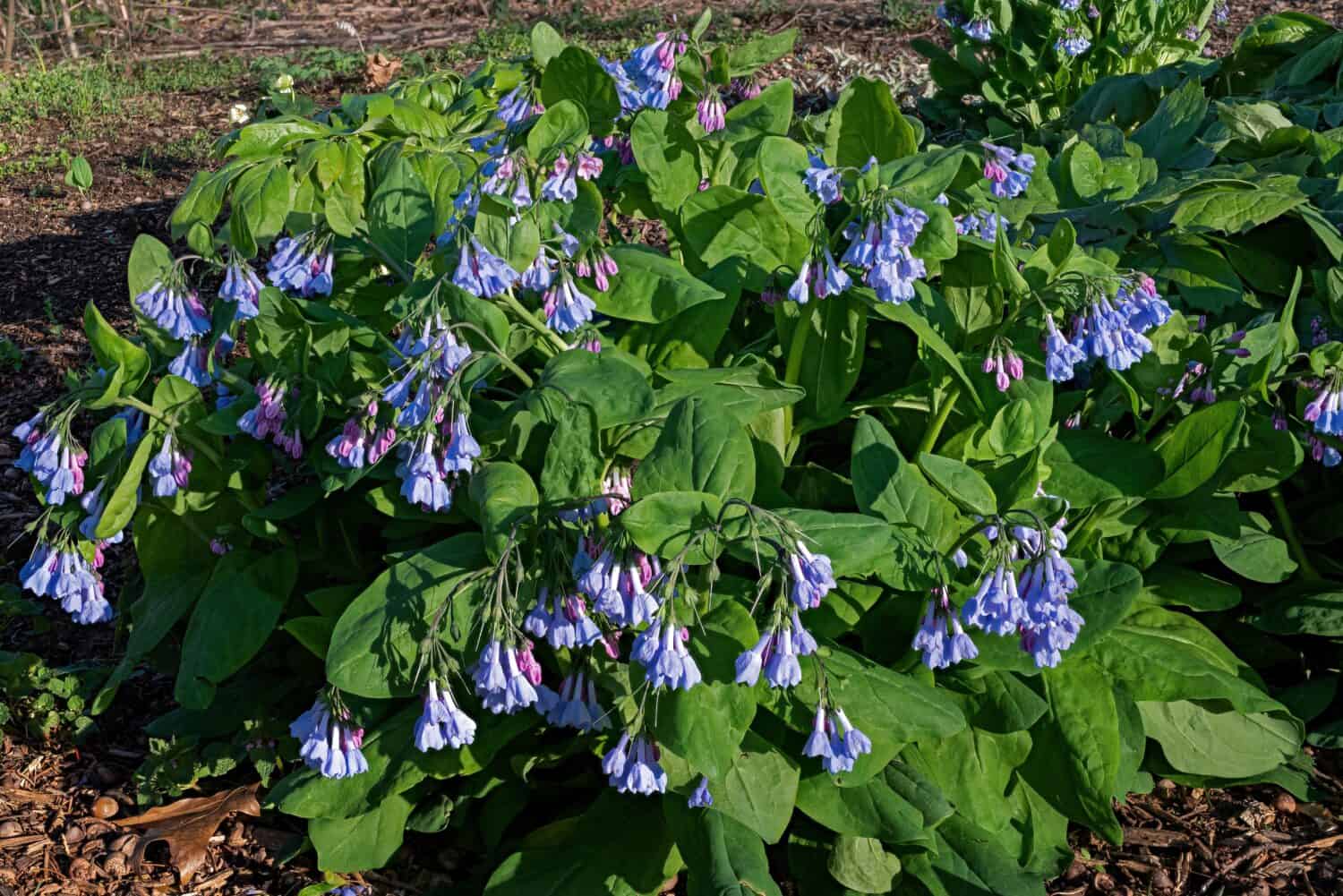
Other common names for Virginia bluebells include Roanoke bells and lungwort oysterleaf.
©Michael G McKinne/Shutterstock.com
One of the first flowers to bloom in the spring, Virginia bluebells are perfect for shady Kentucky gardens. Native to Kentucky, Virginia bluebells produce one-inch-long small tube-shaped flowers. Bumblebees, hummingbirds, and other pollinators are attracted to the blooms. All the flowers will be spent in less than a month, leaving behind small seed pods. Virginia bluebells self-seed readily and will form colonies. By mid-summer, the plant will go dormant. Virginia bluebells prefer full to partial shade and rich, moist, well-drained soils. They can be propagated either by planting from seed or dividing a mature plant. Seeds require cold stratification and should be sown directly into the ground in the late fall. You can also place Virginia bluebell seeds in a bag filled with moist sand. Put the bag in the refrigerator for four to six weeks. Two months before the last frost, put the seeds in pots. Seedlings can be planted outside when the soil is warm enough to turn.
15. Passionflower (Passiflora incarnata)

Jellies and jams can be made from the fruit of the passionflower.
©Tohuwabohu1976/Shutterstock.com
Also called maypops, this perennial flowering vine is popular in Kentucky gardens. As a climber, passionflower vines need a support structure to grow on. After all, passionflower can grow up to 20 feet per year. Plant passionflowers beside an unused trellis and you’ll be rewarded with a display of distinct colorful flowers! Long, wavy, hair-like filaments extend from the center of the flower, making it look almost alien in the Kentucky landscape. Passionflowers bloom from May until August. Flowers give way to a bitter but edible fruit that “may pop” when crushed. Passionflower thrives in full sun to partially shaded conditions. Plant passionflowers in rich, sandy, well-draining soil. Passionflower vines spread by creating suckers, new growth that erupts from the base of the parent plant. Remove the suckers to inhibit the growth of the vine. Propagate passionflowers via cuttings or scarified seed, but be patient. Some passionflower vines can take up to a decade to bloom.
16. Obedient Plant (Physostegia virginiana)
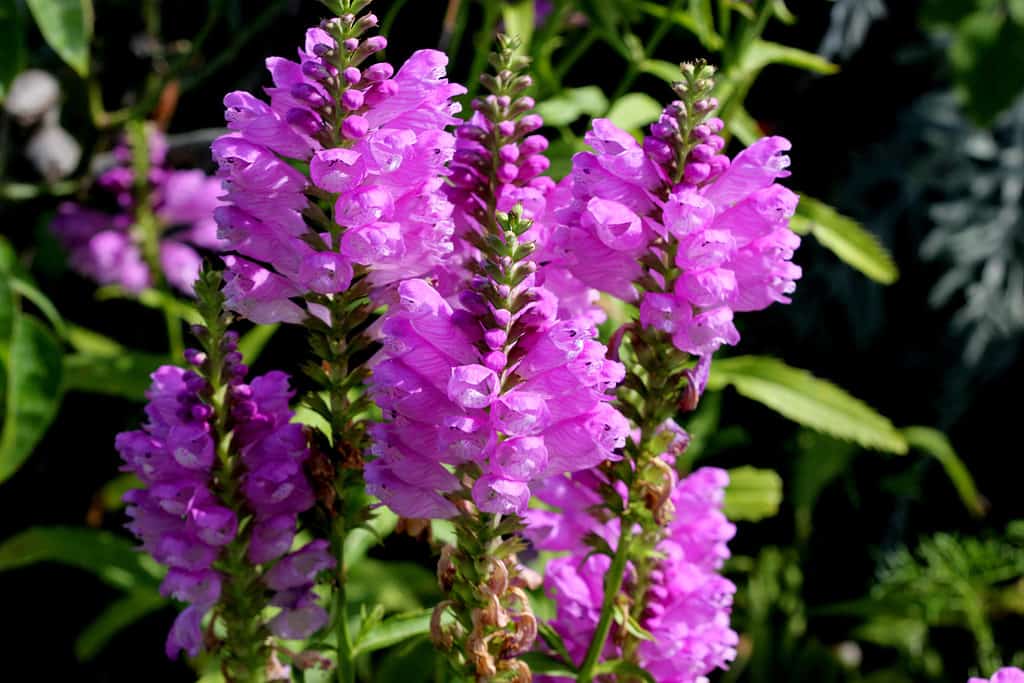
Deer and rabbits avoid obedient plants as a food source because of its bitter-tasting leaves.
©Gurcharan Singh/Shutterstock.com
Perfect for a cottage garden, the obedient plant blooms from bottom to top on sturdy spike-like stems. Often reaching heights of four feet, the obedient plant attracts important pollinators like bumblebees and butterflies. When the flowers are manually manipulated, they will “obediently” stay in the position in which they are placed. Expect obedient plants to bloom from June until September. While they grow well in average, moist, well-draining soil, obedient plants prefer slightly acidic soil. Consider amending alkaline or neutral soils with coffee grounds or compost. Consult your local county extension office for best practices. Depending on the weather, water obedient plants twice a week. Obedient plants prefer full sun exposure but can tolerate partial shade. Since they spread via rhizomes, obedient plants have a tendency to take over small areas. Remove new growth to keep the plant size under control. Obedient plant seeds require cold stratification for two months before sowing. Wait until the last frost has passed before planting. Cuttings from obedient plants will root quickly.
17. Aromatic Aster (Symphyotrichum oblongifolium)
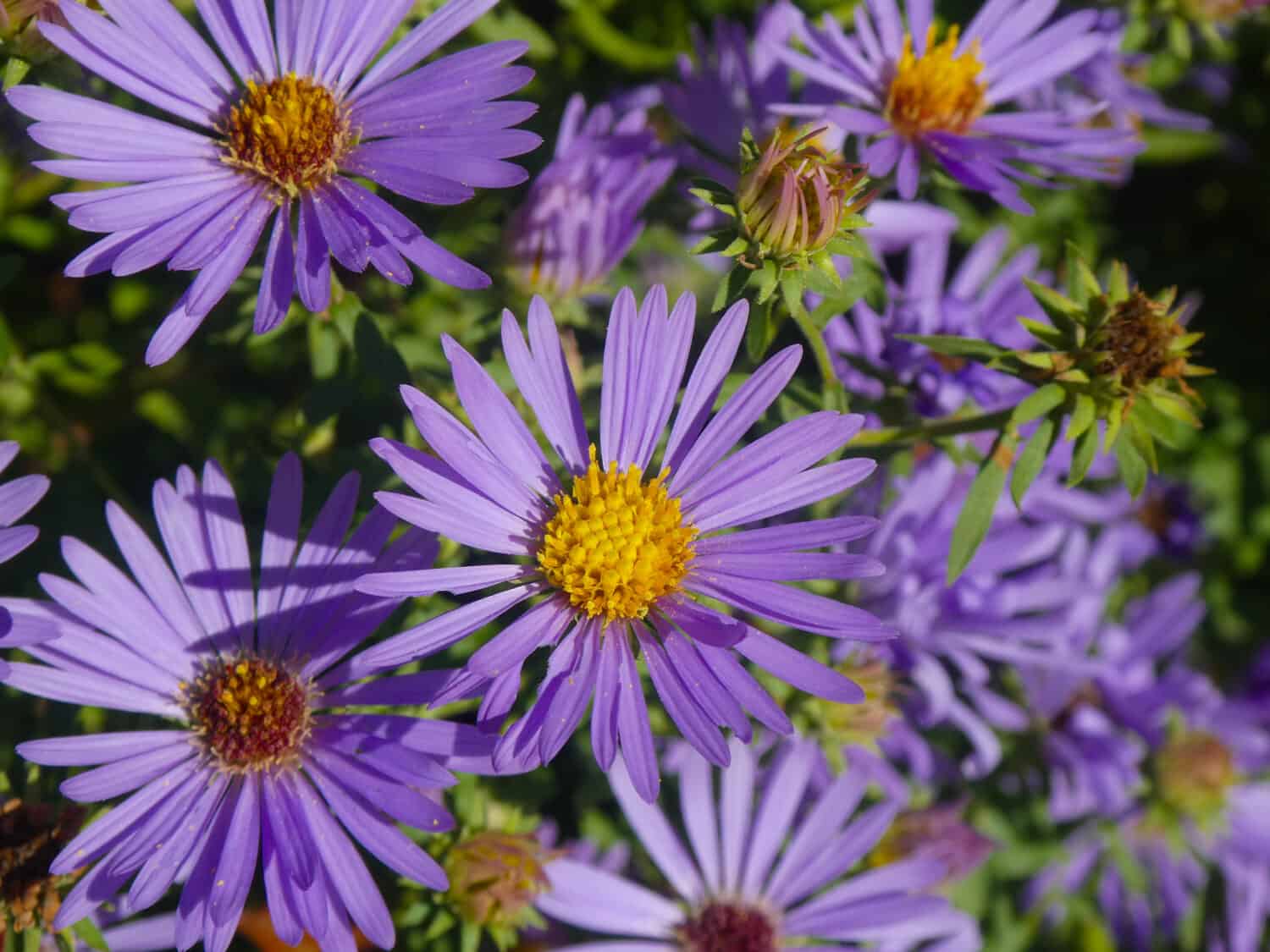
If you were born in September, then the aster is your birth flower.
©ForestSeasons/Shutterstock.com
A fall perennial favorite in Kentucky, aromatic aster is one of the last flowers to bloom before winter. In September, after many other flowers have stopped producing, aromatic aster begins displaying mounds of delicate purple flowers. Butterflies are attracted to the nectar that lies within the flowers. Those blooms will continue until the killing frost arrives. When bruised or crushed, this plant’s foliage emits an aroma reminiscent of balsam. Aromatic aster rarely gets larger than two feet high and three feet wide, making it a nice bedding plant for fall gardens. Plant aromatic aster in a place where it will receive at least six hours of sunlight during the day. Average soil that remains dry or somewhat moist is preferable. Make sure the soil is well-draining to prevent root rot. Aromatic aster spreads slowly, sending runners underground to create new growth. In ideal conditions, aromatic aster will self-seed. After the plant has finished blooming in the winter, cut it back hard to prevent self-seeding and promote growth during the warm seasons.
18. Shasta Daisy (Leucanthemum x superbum)

Created in California in the 19th century, the Shasta daisy is a hybrid of four different varieties of daisy.
©Heeji Choi/Shutterstock.com
Bright yellow centers and dainty white rays make the Shasta daisy one of the most recognizable flowers in the world. Planting cuttings instead of directly sowing seeds in the ground will promote faster blooms. Shasta daisies planted from seed won’t produce flowers until the second growing season. Rooted cuttings will bloom during the first growing season. Mature Shasta daises bloom all throughout the summer. For the best bloom production, plant Shasta daisies in full sun to partial shade. Shasta daisies will flourish in average, dry, and medium soils. Ensure the soil is well-draining, especially in the winter. Overwintering in soil that is too wet damages the flower’s roots. Well-established Shasta daisies grow to between two and four feet tall. Mass plantings of Shasta daisies make an awesome focal point for Kentucky gardens! Be aware, though, that Shasta daisies are toxic to cats and dogs. Shasta daisies can cause contact dermatitis if handled without gloves.
19. Rose (Rosa ‘Red Rascal’)
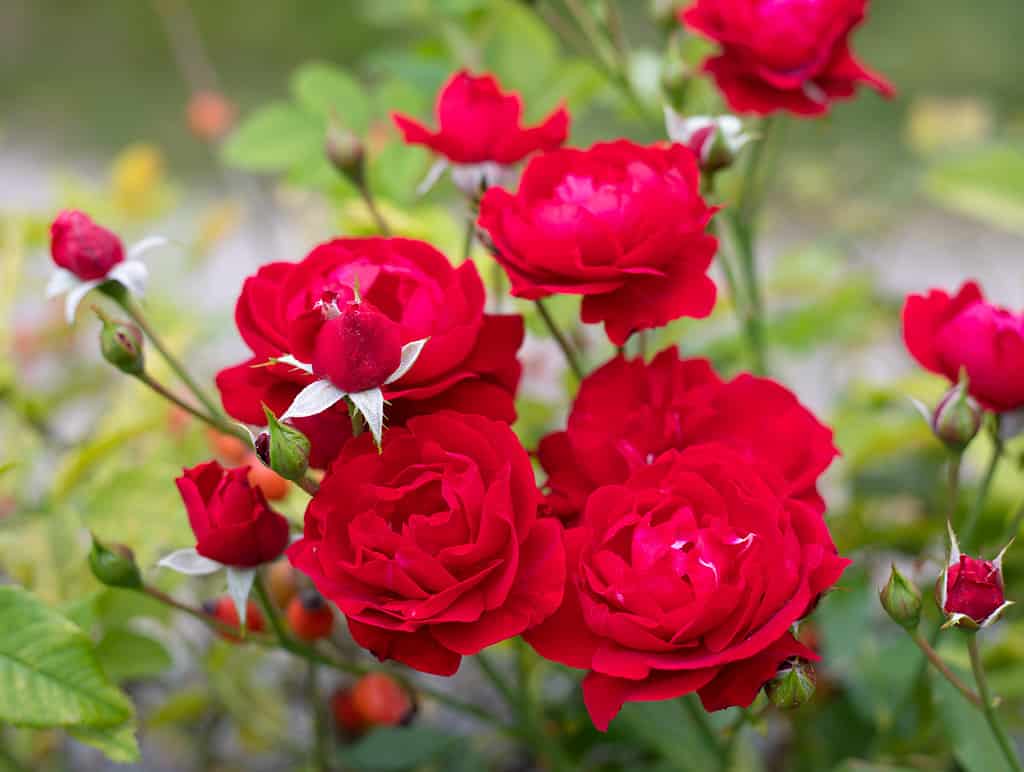
Kentucky’s annual high-profile horse race, the Kentucky Derby, is also known as the “Run for the Roses” because of the large rose garland gifted to the owner of the winning horse.
©Maria Rzeszotarska/iStock via Getty Images
Rosarians, people who cultivate roses, have been cross-breeding different varieties of roses for decades, if not centuries. There are over 150 species of rose and more than 2,000 cultivars! When purchasing roses for your old Kentucky home, make sure they are rated for your specific USDA Cold Hardiness Zone. Red Rascal roses are perfect for people who don’t have much room to grow flowers, such as apartment dwellers. As a patio rose, Red Rascals only grow to about three feet tall. They’ll thrive in small gardens and in containers with the right soil conditions and light exposure.
At the nursery, Red Rascal roses are packed with bare roots. Before placing the flowers in dirt, soak the roots in water for at least six hours. This helps rehydrate the plant, giving it the best chance for success. Red Rascal roses prefer slightly acidic, well-draining soil. Plant these flowers where they will get full, direct sunlight for at least six hours per day. Red Rascal roses should bloom repeatedly from mid-spring until fall. The flowers are slightly fragrant. After the blooming season, prune your Red Rascal by half, taking care to remove any damaged or diseased wood.
20. Pigsqueak (Bergenia crassifolia)
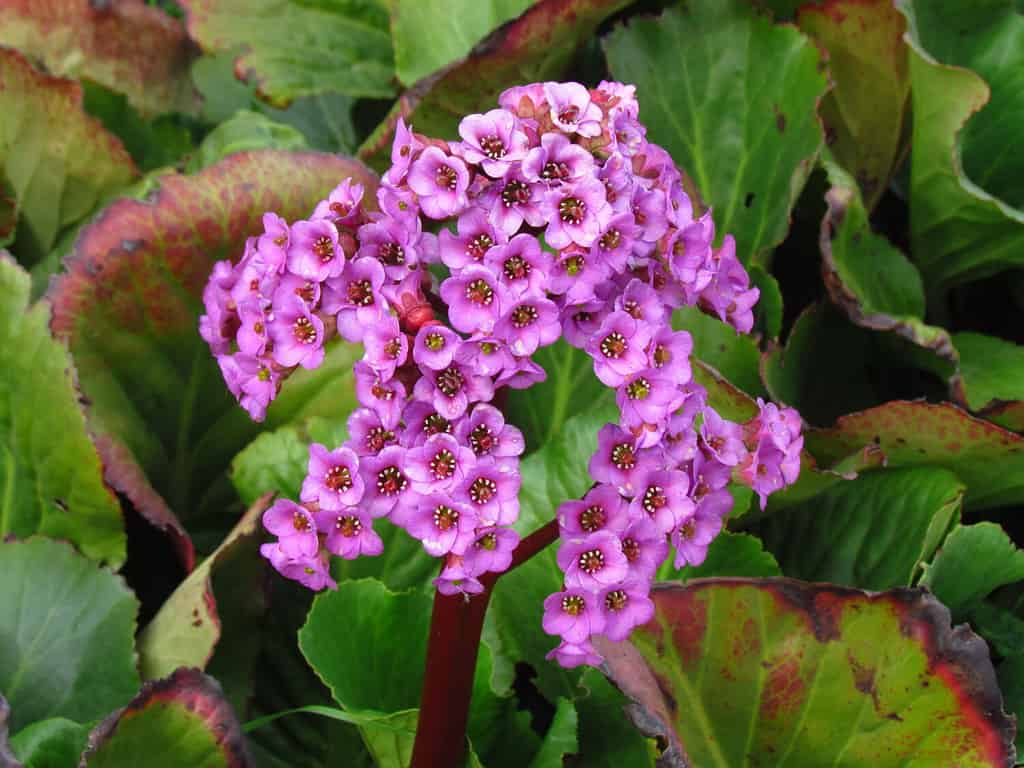
When you rub the leaves of Bergenia crassifolia together between your fingers, it makes a noise like a pig squeaking!
©shalom3/Shutterstock.com
Shade-loving and slow-growing, pigsqueak makes an excellent ground cover or border plant. From March through May, pigsqueak presents small groups of flowers that rise on stalks above its deep green leaves. Honeybees are attracted to the short-lived blooms. Foliage remains green through the remainder of the growing season. In winter, the leaves may exhibit a reddish-bronze coloration. Remove the spent flower stalks as soon as possible. Pigsqueak grows two feet wide and high, reaching maturity within two to five years. Although pigsqueak can tolerate full sun, it performs best in full to partial shade. Pigsqueak prefers rich, moist, well-drained soil. Avoid planting pigsqueak where it will receive full morning sun or harsh winds. Pigsqueak is best propagated by division, which should take place in the fall. Seeds can be started by placing them in potting soil. Pigsqueak seeds need light to germinate, so don’t bury the seeds in the soil. In warm, moist soil, pigsqueak seeds will germinate in four to six weeks.
Summary of the 20 Best Flowers for Kentucky Gardens
| Plant Name | Soil Conditions | Light Requirements |
|---|---|---|
| Garden Petunia | Rich, moist, well-draining | Full sun to partial shade |
| Hardy Chrysanthemum | Rich, moist, well-draining | Full sun |
| Spider Flower | Sandy, loamy, well-draining | Full sun |
| Creeping Zinnia | Rich, loamy, well-draining | Full sun |
| Threadleaf Coreopsis | Rocky, well-draining | Full sun |
| Purple Coneflower | Variable, well-draining | Full sun |
| Daylily | Chalky, loamy, well-draining | Full sun |
| Autumn Joy Sedum | Poor to average, rocky, well-draining | Full sun |
| Mealy Cup Sage | Loamy, well-draining | Full sun to partial shade |
| Common Impatiens | Rich, moist, well-draining | Partial to full shade |
| Cardinal Flower | Rich, moist | Full sun to partial shade |
| Black-Eyed Susan | Loamy, well-draining | Full sun |
| Tall Goldenrod | Variable, well-draining | Full sun to partial shade |
| Virginia Bluebells | Rich, moist, well-draining | Partial to full shade |
| Passionflower | Rich, sandy, well-draining | Full sun to partial shade |
| Obedient Plant | Average, moist, slightly acidic, well-draining | Full sun to partial shade |
| Aromatic Aster | Dry to somewhat moist, well-draining | Full sun |
| Shasta Daisy | Average to medium, dry, well-draining | Full sun to partial shade |
| ‘Red Rascal’ Rose | Rich, slightly acidic, well-draining | Full, direct sunlight |
| Pigsqueak | Rich, moist, well-draining | Full to partial shade, can tolerate full sun |
Thank you for reading! Have some feedback for us? Contact the AZ Animals editorial team.

